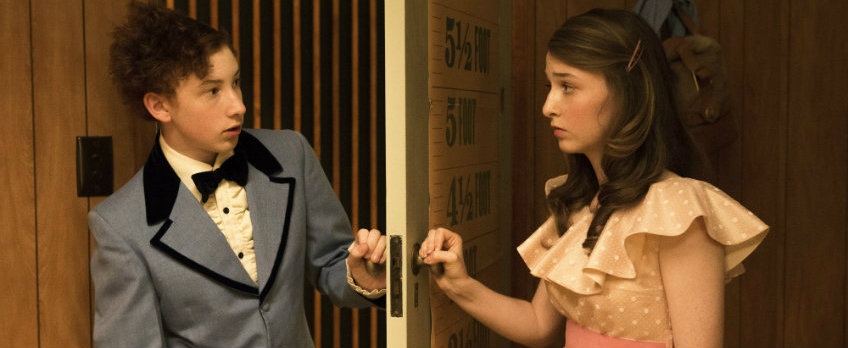Girl Asleep From Stage to Screen: an Interview with Rosemary Myers

Ella Donald, Critics Campus 2016
Girl Asleep may be Rosemary Myers’s first film, but she’s far from a newcomer – in addition to working for a variety of theatre companies and the ABC, which has seen her work nominated for multiple Helpmann Awards and other accolades, she has also been the artistic director of the groundbreaking Windmill Theatre Company in South Australia since 2010. Her role as artistic director saw the company’s focus expand into making theatre for teenagers, a change that saw the original stage version of Girl Asleep premiere as part of the Adelaide Festival in 2014.
Now a film, Girl Asleep comes to MIFF on the back of monumental success at a variety of festivals including Adelaide, Berlin, Seattle, and Sydney. Set in 1977 Australia, the film focuses on 14-year-old Greta Driscoll, who is painfully shy and nervous about leaving her childhood. Having just arrived at a new school, her parents throw her a birthday party to try and coax her out of her shell. It’s a night of absurdity, excitement, and fear – one that goes from bad to worse when she falls asleep during the party and is propelled into a parallel world that is party fairytale and part nightmare.
With its period-appropriate, dollhouse-like aesthetic and symmetrical framing, Girl Asleep has earned plenty of comparisons to Wes Anderson and Spike Jonze. It’s these signature qualities that make the film exciting to watch, that give it unexpected and energetic flourishes. Myers says these influences, along with other film references, are both what makes Windmill so unique and appealing to teenagers and Girl Asleep a logical choice for a film: “Often a lot of theatre on stage is about mid-life crises. It’s not that relevant to young people in either form or content.”
“We make theatre in an age where screen is the dominant artistic medium of our time,” Myers says. “[Films] kind of influence our theatre making, and they influence our audience as well, because the audience has evolved so many cool kinds of literacies as a result of film.”

Coming from a theatre background and working with many creatives from the play – including writer Matthew Whittet, costume and production designer Jonathon Oxlade, and actors Eamon Farren and Amber McMahon – made for a more communal filmmaking process. “Theatre is a collaborative medium and so is film, but I think the way we particularly work in the theatre with our collaborators … it’s a very tight kind of dialogue when we’re conceiving the work,” Myers says. “We want it to heel like a holistic thing when we’re imagining what we want it to be.”
“That naturally continued into the filmmaking process and then bought Andy [Andrew Commis, cinematographer] and Kaz [Karryn de Cinque, film editor] into that as well, going, ‘This is the sensibility’. They got really excited about that, and then started chipping in their own ideas to how to realise that sensibility. There’s a lot of developing the context across the group and the language.”
For Myers, reinterpreting Girl Asleep on film also offered new insights. Shifting from stage to screen meant that Myers had full control over the gaze of the audience – the progressively more mobile camera indicative of Greta’s world. “In theatre you really have to represent the psyche of the character through the visceral wholeness of the experience, because you can’t zoom in on a face,” Myers says. “The film does offer up so much in the way that you put out point of view in film, but then in the way we represent what she’s experiencing in the way we enlarge the world, the way her family is slightly enlarged and then that takes another leap when we go into the dream.”

Aside from form, however, a major change from play to film that the lead roles are played by teenagers. For Myers, it was an exciting process that brought new insights to the material courtesy of her two leads: Bethany Whitmore, who plays Greta, and Harrison Feldman, who plays Elliott. “I spent three days with them about a month before we started shooting, and we really just sat down and went through the story and we read the script and then just stopped and talked about it at length about what’s going on in this scene,” Myers says.
“I think it does add a really strong element of authenticity automatically to the storytelling. I mean, in the play there’s more a stylised layer on it, because this is adults sharing their experiences to some degree. So there’s an element of that in the performance. But in the film, it’s like, ‘This is really through the eyes of these young people’, and it gives it that much more authenticity.”
Girl Asleep is, of course, a product of the South Australian film industry, joining the likes of The Babadook and 52 Tuesdays, some of the most successful Australian films of the past few years. According to Myers, Adelaide itself is how these daring films, which have gained attention at festivals like Sundance and Berlin, happen. “There’s amazing things happening in the smaller cities and actually, I think there’s great things for artists about living in smaller cities – it’s cheaper, you can be a lot more focused. There’s not so much, like, big end of town industries. You’ve got crews and technical people really prepared to push the envelope – not so much clock-on, clock-off mentality,” she says. “They’re actually really driven and you can focus down on being a bit more experimental, you can be a bit more lateral.”